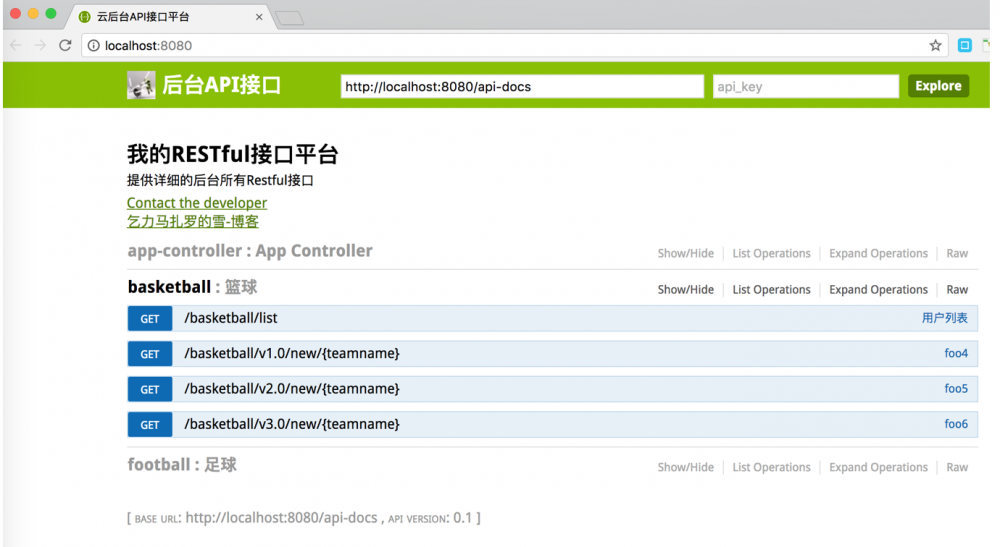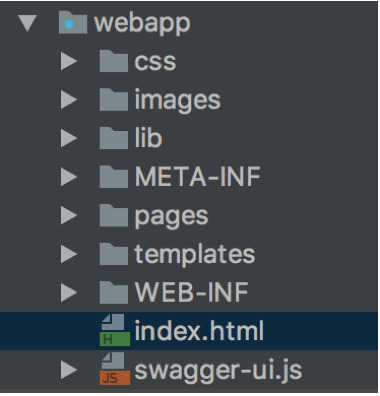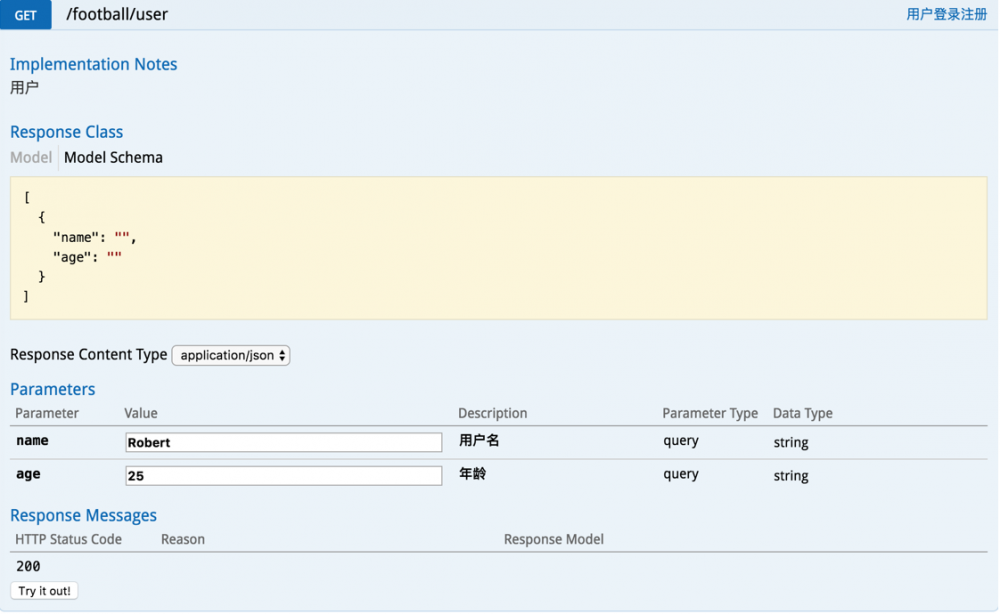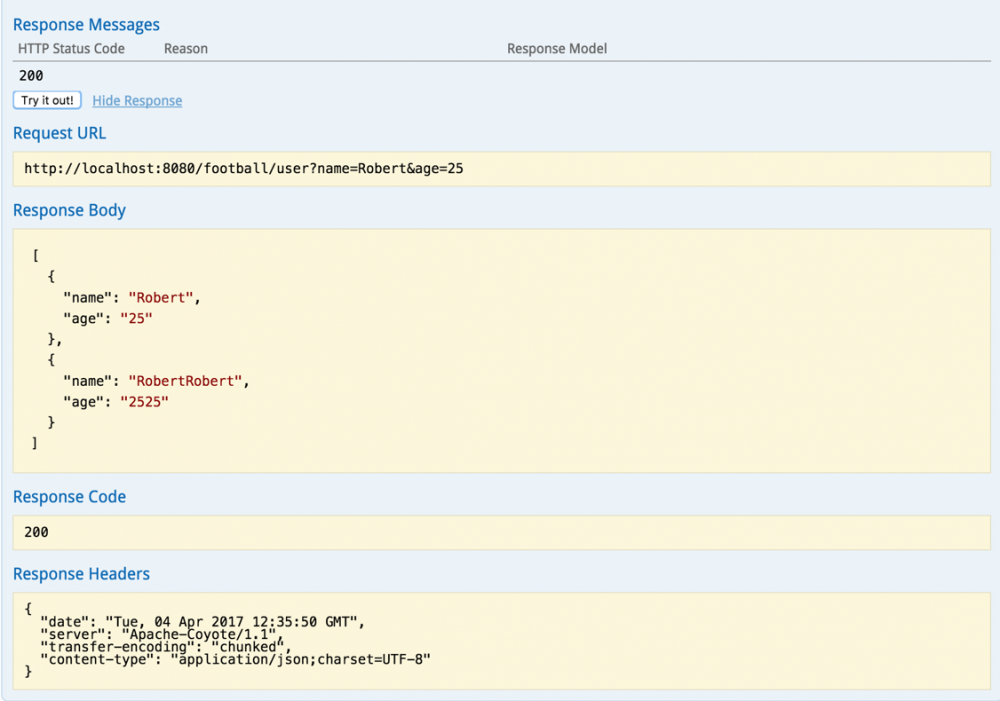SpringMVC 开发 — 使用Swagger搭建接口请求页面
Swagger是一款RESTful接口的文档在线自动生成模板和页面,使用和平台以及语言无关。目前在很多公司以及实际项目中大量用到。可以把Swagger理解为接口文档,后台写好的代码可以直接生成前端接口文档页面,接口调用这可以通过这个页面发送接口请求,进行接口测试或调用。使用起来非常方便。使用了Swagger之后,就不需要再去维护其他的接口文档了,节省了很多的成本。本文使用的项目案例上传至 https://github.com/chenyufeng1991/StartSpringMVC.git 。本文将会来介绍如何搭建一个完整的Swagger框架。Swagger的官方地址为: http://swagger.io/ 。一个简答的Swagger页面如下图所示:

(1)Swagger在Github上的地址为: https://github.com/swagger-api/swagger-ui 。大家可以下载该项目,然后把dist目录下的所有内容都加入到自己项目的webapp目录下。大家也可以下载我的StartSpringMVC项目,把webapp目录下的css、images、lib、index.html和swagger-ui.js导入到自己的项目中即可。其中显示的前端页面就是index.html.

(2)然后需要在项目中新加一个类,作为swagger的配置文件,我在StartSpringMVC中的类是“CustomJavaPluginConfig”,该类的实现如下:
@Configuration
@EnableWebMvc
@EnableSwagger
public class CustomJavaPluginConfig extends WebMvcConfigurerAdapter {
private SpringSwaggerConfig springSwaggerConfig;
@Autowired
public void setSpringSwaggerConfig(SpringSwaggerConfig springSwaggerConfig) {
this.springSwaggerConfig = springSwaggerConfig;
}
@Bean
public SwaggerSpringMvcPlugin customImplementation() {
return new SwaggerSpringMvcPlugin(this.springSwaggerConfig)
.apiInfo(apiInfo()).includePatterns(".*")
.useDefaultResponseMessages(false)
// .pathProvider(new GtPaths())
.apiVersion("0.1").swaggerGroup("user");
}
private ApiInfo apiInfo() {
ApiInfo apiInfo = new ApiInfo("我的RESTful接口平台",
"提供详细的后台所有Restful接口", "http://blog.csdn.net/chenyufeng1991",
"yufengcode@gmail.com", "乞力马扎罗的雪-博客", "http://blog.csdn.net/chenyufeng1991");
return apiInfo;
}
@Override
public void configureDefaultServletHandling(
DefaultServletHandlerConfigurer configurer) {
configurer.enable();
}
class GtPaths extends SwaggerPathProvider {
@Override
protected String applicationPath() {
return "/restapi";
}
@Override
protected String getDocumentationPath() {
return "/restapi";
}
}
}
(3)对于一个实体模型,需要使用swagger去标识。如下面的Student模型,其中的@ApiModel、@ApiModelProperty都是属于Swagger的注解。如果需要在接口中返回模型对象,则需要使用以下的方式去注解。
@ApiModel(value = "学生对象", description = "student")
public class Student {
@ApiModelProperty(value = "姓名", required = true)
String name;
@ApiModelProperty(value = "年龄", required = true)
String age;
public Student(String name, String age) {
this.name = name;
this.age = age;
}
public String getName() {
return name;
}
public void setName(String name) {
this.name = name;
}
public String getAge() {
return age;
}
public void setAge(String age) {
this.age = age;
}
}
(4)在进行接口设计的Controller中,同样需要使用Swagger注解。其中下面的@Api、@ApiOperaction、@Apiparam都是Swagger注解,其中@Api表示这是一个需要Swagger表示的类;@ApiOperaction表示这是一个需要Swagger修饰的接口,其中表明了请求方式、说明等信息。@ApiParam表示该接口输入的参数,value是参数的值说明,required表示该参数是否是必须的。
@Api(value = "football", description = "足球", produces = MediaType.APPLICATION_JSON_VALUE)
@Controller
@RequestMapping("football")
public class FootballController {
@ApiOperation(value = "用户登录注册", notes = "用户", httpMethod = "GET", produces = MediaType.APPLICATION_JSON_VALUE)
@ResponseBody
@RequestMapping(value = "user", method = RequestMethod.GET)
public List<Student> foo(
@ApiParam(value = "用户名", required = true) @RequestParam String name,
@ApiParam(value = "年龄", required = true) @RequestParam String age
) {
//获取请求的参数,需要和链接中的参数名一致
//推荐使用HttpServletRequest的方式来获取参数,GET、POST的参数都可以接收
List<Student> list = new ArrayList<Student>();
Student student = new Student(name, age);
Student student1 = new Student(name + name, age + age);
list.add(student);
list.add(student1);
return list;
}
@ApiOperation(value = "用户登录注册2", notes = "用户2", httpMethod = "POST", produces = MediaType.APPLICATION_JSON_VALUE)
@ResponseBody
@RequestMapping(value = "customer/login", method = RequestMethod.POST)
public String foo2(
@ApiParam(value = "用户名", required = true) @RequestParam String name
) {
return name;
}
}
(5)重要的是,要在pom.xml中加入swagger的依赖:
<!-- Swagger-mvc -->
<dependency>
<groupId>com.mangofactory</groupId>
<artifactId>swagger-springmvc</artifactId>
<version>1.0.2</version>
</dependency>
(6)完成后的运行界面如下图所示。大家可以根据自己的实际需求自定义页面元素。


- 本文标签: XML java lib https UI plugin CTO REST mail description 下载 API 模型 json spring dist git 配置 bean 需求 SpringMVC pom tar 博客 RESTful id Document 目录 provider ip map Action 代码 list 测试 http CSS IO HTML 开发 servlet cat Property GitHub value web src js IDE 自动生成 App 参数 学生 message SDN
- 版权声明: 本文为互联网转载文章,出处已在文章中说明(部分除外)。如果侵权,请联系本站长删除,谢谢。
- 本文海报: 生成海报一 生成海报二










![[HBLOG]公众号](https://www.liuhaihua.cn/img/qrcode_gzh.jpg)

